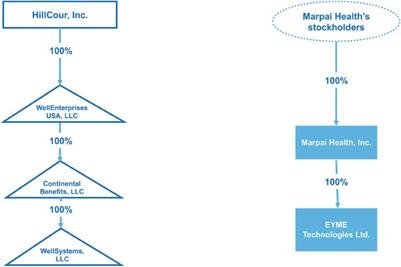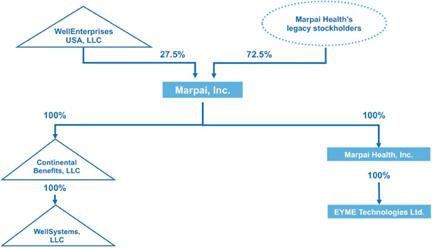Comparison of the Years December 31, 2021 and 2020
Revenues and Cost of Revenue
During the years ended December 31, 2021 and 2020, our total revenue was $14,226,794 and $0, respectively. The revenues for the year ended December 31, 2021 consists exclusively of Continental Benefits’ revenues. Continental Benefits results of operations have been included in our consolidated results of operations since its acquisition on April 1, 2021.
During the years ended December 31, 2021 and 2020, our cost of revenue exclusive of depreciation and amortization was $10,289,578 and $0, respectively. The cost of revenue for the year ended December 31, 2021 consists exclusively of Continental Benefits’ cost revenue. Continental Benefits results of operations have been included in our consolidated results of operations since its acquisition on April 1, 2021.
Total cost of revenues consists of (i) service fees, which primarily include vendor fees associated with the client’s benefit program selections, (ii) the direct labor cost associated with claim management and processing services, and (iii) direct labor costs associated with providing customer support and services to the clients, members, and other external stakeholders.
Research and Development
We incurred $1,733,964 of research and development expenses for the year ended December 31, 2021 compared to $1,766,388 for the year ended December 31, 2020, a decrease of $32,424 or 1.8%. The decrease is attributable to having increased expenditures amounting to approximately $877,000 associated primarily with a higher number of research and development personnel offset by an increase of approximately $895,000 in the amount of research and development costs of internal use software that were capitalized in the year ended December 31, 2021 as compared to the year ended December 31, 2020. We started capitalization of certain research and development costs when the project reached the development stage in August 2020, which resulted in a substantial portion of the software development costs being capitalized starting then through December 31, 2021.
General and Administrative Expenses
We incurred $8,055,572 of general and administrative expenses for the year ended December 31, 2021 compared to $1,499,376 for the year ended December 31, 2020, an increase of $6,556,196. The increase for year ended December 31, 2021 was due to general and administrative expenses of Continental Benefits amounting to approximately $3,981,000 (which were not included in the operating results of the Company prior to its acquisition on April 1, 2021) as well as increase in the general and administrative expenses of Marpai, Inc. amounting to approximately $2,716,000, primarily due to an increase in accounting and legal services in the amount of approximately $550,100 related to the acquisition of Continental Benefits, as well as increases in the cost of personnel and professional fees associated with the growth of the Company over the last year as well as its transition from a private company to a public company.
Sales and Marketing Expenses
We incurred $4,965,209 of sales and marketing expenses for the year ended December 31, 2021 compared to $27,583 for the year ended December 31, 2020, an increase of $4,937,626. This increase was primarily due to an increase of approximately $1,233,000 in branding expense, and Continental Benefits’ sales and marketing expenses from April 1, 2021, the date of the Acquisition, through December 31, 2021 in the amount of approximately $3,704,000 (which were not included in the operating results of the Company prior to its acquisition on April 1, 2021).
Information Technology Expenses
We incurred $2,492,060 of information technology expenses for the year ended December 31, 2021 compared to $0 for the year ended December 31, 2020. The information technology expenses for the year ended December 31, 2021 consist exclusively of Continental Benefits’ expenses which have been included in our consolidated results of operations since its acquisition on April 1, 2021.


